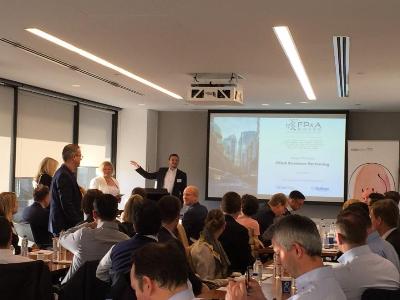 The Sydney FP&A Board meeting was held on the 18th of July 2019 at the boardroom of Michael Page’s Sydney offices overlooking the Sydney harbour on a beautiful winter’s day. It was the perfect location to discuss the very topical issue of FP&A Business Partnering. The event was made possible through the sponsorship of Apliqo and Michael Page.
The Sydney FP&A Board meeting was held on the 18th of July 2019 at the boardroom of Michael Page’s Sydney offices overlooking the Sydney harbour on a beautiful winter’s day. It was the perfect location to discuss the very topical issue of FP&A Business Partnering. The event was made possible through the sponsorship of Apliqo and Michael Page.
A very engaged audience of 40 senior finance professionals from a broad mix of industries turned out to hear the Managing Director of the FP&A Trends Group and Founder of the International FP&A Board, Larysa Melnychuk together with one of the thought leaders on business partnering in Australia, Andrew Jepson. The discussion was followed by a case study from Ian Croft, Director of Financial Planning and Analysis at Luxottica, and then a very positive and engaged group discussion which resulted in 5 thoughtful insights on the key steps to implementing an effective FP&A business partnering model.
As team members introduced themselves at the start, they were asked to use one word to describe the best FP&A business partner they had worked with. As Andrew noted the words on the flipchart, it quickly became evident that there were key trends emerging around efficiency and effectiveness and collaboration and passion.
Latest Trends in FP&A
Larysa then covered topics surrounding the trends and challenges of surrounding the FP&A world, the dual roles of an FP&A business partner and presented the concept of 4 roles which every FP&A team should ensure – architect, analyst, storyteller and influencer.
These discussions, in particular, the issue of the dual role (challenging the status quo and educating) and the 4 roles generated robust discussion about the methods and benefits of constructive challenge that key FP&A business partners need to adopt. When the discussion turned to the focus on the past or future someone from the crowd eloquently pointed out that FP&A needs to own telling the story in order to get the desired outcomes. It was lamented that many accountants struggle with the role of storyteller and influencer and still feel that their technical skills are critical.

Ian Croft from Luxoticca then presented a very well-received experience of what has made FP&A work in his career and introduced his definition of commercial acumen “does it smell right”. The key takeouts from Ian’s talk were that understanding the business and the data was most important and that they enabled one to understand what really matters.
Group Discussion
Attendees then split into five groups and brainstormed about key steps to implementing an effective FP&A business partnering model. The five groups presented some good insights into the model. The key themes that came out were the integrity and accountability of data, the need to start the model identifying the needs and wants of stakeholders and establishing a trusting relationship with those stakeholders.
The outcomes from the 5 groups are presented, grouped into themes is presented in tabular form below:
Larysa then rounded up the discussions and finished by presenting the findings of the Carnegie Institute of Technology which indicated that 85% of your financial success is due to skills in “human engineering,” your personality and ability to communicate, negotiate, and lead. And shockingly, only 15 % is due to technical knowledge.

We were fortunate to interview two participants post the forum on their views.
Andreina Lim, Finance Excellence Team Lead at Unilever, liked the fact there were new ideas about business partnering that she can take back to her business. She felt it was good to hear what other businesses are doing and wanted future events to have more workshops and networking where participants can go into different groups and discuss different options and ideas about how we can take FP&A to a different level. She believed the insights she gained from conversations with other professionals was very useful and more workshops and networking will establish different insights.
Another participant thought the workshop was informative and it was useful to understand best practice about setting up an FP&A department. The workshop gave him confidence that his decisions back at work were on the right track. He enjoyed the case studies and hearing about larger organisations who are further along the FP&A journey. He also believes the opportunity to network with a wide variety of finance professionals was very positive which gave him some good contacts that he can reach out to in future.
The last part of the meeting was dedicated to networking and everyone appreciated the catering provided by Michael Page. In the networking that followed, many participants felt the meeting was well structured and the calibre of the attendees was very high and people were very open to sharing the journey of their organisation and what they were doing. Many were looking forward to meeting again.




